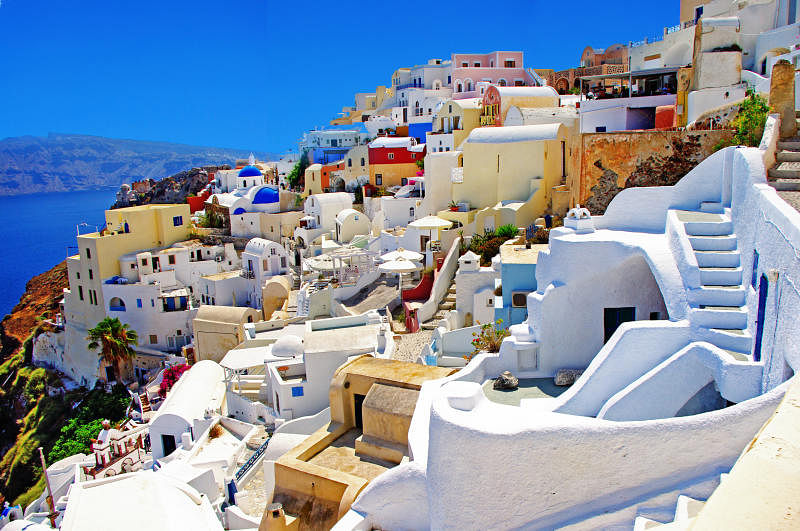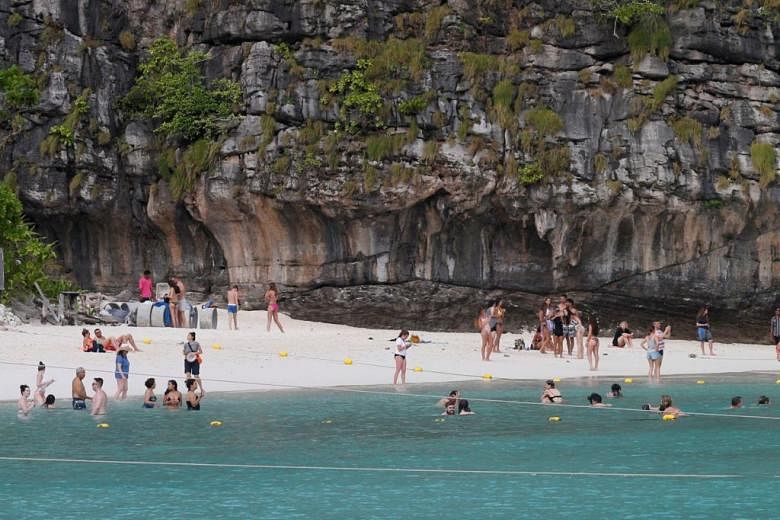One of Thailand's best-known tourist attractions, Maya Bay, the backdrop for the 2000 film The Beach, will be closed indefinitely to allow it to recover from the impact of hordes of tourists.
The constant influx of thousands of day-trippers had caused the island's beach to erode and led to an increase in pollution. As such, the decision was made in June to close the beach for four months.
However, a survey of the problem revealed that the temporary ban would be insufficient to solve the beach's woes. The decision to close the beach indefinitely was then announced by Thailand's Department of National Parks, Wildlife and Plant Conservation on Monday (Oct 1).
The closure of the popular tourist destination is only one of a few recently-announced measures by attractions that are limiting visitors to deal with problems arising from overcrowding.
Here is a list of some other places that are introducing measures to keep tourist numbers in check.
1. Boracay island closed to tourists for six months since April this year

The resort island of Boracay was closed to tourists for six months from April 26 to fix sewage and environment-related problems that led Philippines President Rodrigo Duterte to describe it as a "cesspool" in February.
"You go into the water, it's smelly. Smells of what? Sh*t," he had said.
He also said unless something was done, "there will be a time that no more foreigner will go (to Boracay) because he, when he goes back to where he belongs, he will be full of sh*t, going back and forth to the restroom".
Boracay's degradation has been blamed on the failure of the local government to enforce ordinances on marine conservation, garbage and sanitation, and zoning and construction, among other issues.
At least 300 hotels, resorts and inns had been ignoring an ordinance that required them to build their own sewage and wastewater treatment facilities. They had instead been dumping waste into canals meant only for rainwater and surface overflow.
Boracay will open its doors to tourists once more on Oct 26, but the island known for its party atmosphere will crack down on drinking and smoking on its beaches, while only 19,000 tourists will be allowed at any one time.
2. Three-hour limit for visits to India's Taj Mahal

Visits to the Taj Mahal are capped at three hours as of April, India's most popular tourist attraction announced.
The measure is aimed at crowd control. According to the Archaeological Survey of India (ASI), the Unesco World Heritage site can receive up to 50,000 visitors a day during peak season.
The white marble mausoleum draws an estimated seven to eight million people a year.
ASI officials told The Times of India in April that tickets will be time-stamped and will likely be manually checked by staff.
The measure comes months after the authorities said it would be restricting the number of local tourists allowed to enter to 40,000 per day.
The Taj Mahal was built by Mughal emperor Shah Jahan as a tomb for his beloved wife Mumtaz Mahal, who died giving birth in 1631.
3. Santorini limits number of cruise passengers to 8,000 per day

Greek island Santorini has capped cruise visitors at 8,000 this year.
The figure was 12,000 last year.
In 2015, there were 636 cruise ships taking 790,000 people to the scenic isle, CNTraveler.com reported.
Only 439 cruise vessels have registered to visit the island this year, Greek news site Kathimerini reported.
A new scheduling system has also been implemented, with cruise companies asked to modify arrival days and stagger landing times.
Last year, The Guardian reported about how locals in Santorini said it has hit saturation point.
"Our island's reputation is cause for joy but also frightens me hugely," Manolis Karamolegos, the head of the Santorini Hoteliers' Association, told The Guardian. "I worry about tomorrow, of where it will lead. Tourism is posing a risk to our social cohesion. Everywhere, people are building or renting out their homes."
4. Cinque Terre manages tourist numbers with online ticketing

Thousands of tourists flock to Cinque Terre, a string of seaside villages on the coastline of the Italian Riviera, every year.
Last year, the area received about 2.5 million visitors.
To stem the tide, an online ticketing system was introduced last year to manage tourism numbers.
Additionally, officials hope to establish a tourist-only train system that will let through only tourists who have bought tickets.
Its capped entry cards include services such as rail connections and are linked with an app giving real-time information on visitor numbers in each village.
SOURCES: AFP, Mashable, Reuters, Stuff.co, The Guardian, The Nation, The National Herald

